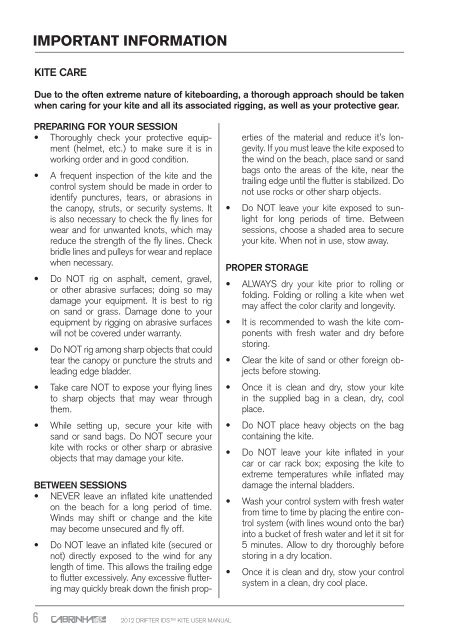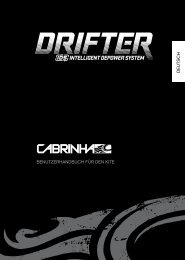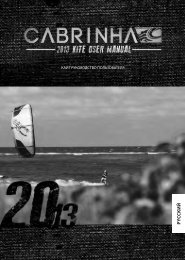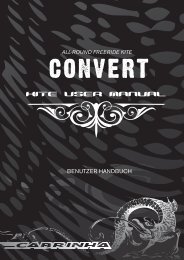2012 drifter ids⢠kite user manual manuel d'utilisation ... - Cabrinha
2012 drifter ids⢠kite user manual manuel d'utilisation ... - Cabrinha
2012 drifter ids⢠kite user manual manuel d'utilisation ... - Cabrinha
Create successful ePaper yourself
Turn your PDF publications into a flip-book with our unique Google optimized e-Paper software.
IMPORTANT INFORMATIONKITE CAREDue to the often extreme nature of <strong>kite</strong>boarding, a thorough approach should be takenwhen caring for your <strong>kite</strong> and all its associated rigging, as well as your protective gear.PREPARING FOR YOUR SESSION• Thoroughly check your protective equipment(helmet, etc.) to make sure it is inworking order and in good condition.• A frequent inspection of the <strong>kite</strong> and thecontrol system should be made in order toidentify punctures, tears, or abrasions inthe canopy, struts, or security systems. Itis also necessary to check the fly lines forwear and for unwanted knots, which mayreduce the strength of the fly lines. Checkbridle lines and pulleys for wear and replacewhen necessary.• Do NOT rig on asphalt, cement, gravel,or other abrasive surfaces; doing so maydamage your equipment. It is best to rigon sand or grass. Damage done to yourequipment by rigging on abrasive surfaceswill not be covered under warranty.• Do NOT rig among sharp objects that couldtear the canopy or puncture the struts andleading edge bladder.• Take care NOT to expose your flying linesto sharp objects that may wear throughthem.• While setting up, secure your <strong>kite</strong> withsand or sand bags. Do NOT secure your<strong>kite</strong> with rocks or other sharp or abrasiveobjects that may damage your <strong>kite</strong>.BETWEEN SESSIONS• NEVER leave an inflated <strong>kite</strong> unattendedon the beach for a long period of time.Winds may shift or change and the <strong>kite</strong>may become unsecured and fly off.• Do NOT leave an inflated <strong>kite</strong> (secured ornot) directly exposed to the wind for anylength of time. This allows the trailing edgeto flutter excessively. Any excessive flutteringmay quickly break down the finish propertiesof the material and reduce it’s longevity.If you must leave the <strong>kite</strong> exposed tothe wind on the beach, place sand or sandbags onto the areas of the <strong>kite</strong>, near thetrailing edge until the flutter is stabilized. Donot use rocks or other sharp objects.• Do NOT leave your <strong>kite</strong> exposed to sunlightfor long periods of time. Betweensessions, choose a shaded area to secureyour <strong>kite</strong>. When not in use, stow away.PROPER STORAGE• ALWAYS dry your <strong>kite</strong> prior to rolling orfolding. Folding or rolling a <strong>kite</strong> when wetmay affect the color clarity and longevity.• It is recommended to wash the <strong>kite</strong> componentswith fresh water and dry beforestoring.• Clear the <strong>kite</strong> of sand or other foreign objectsbefore stowing.• Once it is clean and dry, stow your <strong>kite</strong>in the supplied bag in a clean, dry, coolplace.• Do NOT place heavy objects on the bagcontaining the <strong>kite</strong>.• Do NOT leave your <strong>kite</strong> inflated in yourcar or car rack box; exposing the <strong>kite</strong> toextreme temperatures while inflated maydamage the internal bladders.• Wash your control system with fresh waterfrom time to time by placing the entire controlsystem (with lines wound onto the bar)into a bucket of fresh water and let it sit for5 minutes. Allow to dry thoroughly beforestoring in a dry location.• Once it is clean and dry, stow your controlsystem in a clean, dry cool place.6 <strong>2012</strong> DRIFTER IDS KITE USER MANUAL
















